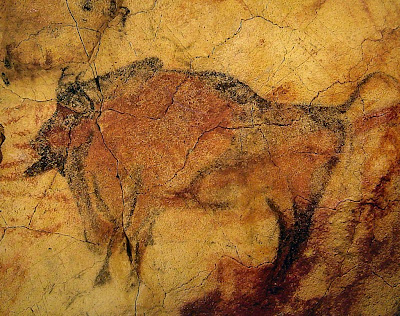LOCATION:
Near Santillana del Mar, Cantabria, northern Spain. 30km west of Santander. Motorway A-67, exit Santillana del Mar, National highway 611 and Autonomic road 6316 to Santillana del Mar. Follow the signs to Altamira Museum.
The Altamira Cave consists of a series of rooms and passages shaped like an S. The main hall lies about 30m from the entrance and measures about 18 by 9m.
The world famous feature of this cave is found on the ceiling: coloured paintings, mainly from the beginning of the Magdalenian period, about 15.000 years ago. Most paintings show bisons, but there are also two wild boars, some horses, a hind, and some other figures in a simpler style. There are eight engraved anthropomorphic figures, various handprints, and hand outlines.
The surprising quality and exceptionally well preserved state of the paintings caused the specialists to doubt whether they were genuine. Their discoverer died before his find had been officially accepted as authentic. At the beginning of the century the scientific community accepted them as unadulterated, after several comparable remains from the stone age were discovered in this area. But Altamira is still the most exceptional evidence of the Magdalénian culture in southern Europe.

The habitation of the cave starts in the Aurignacian (Perigordian) period, to which the first figure-like symbols etched in the walls belong. It was used more intensely in the Solutrean and Magdalenian periods. Proof of the habitation are the abundant stone material and the organic remains dated with the C14-dating.
The drawings show bisons, horses, red deer and boar. The animal figures are large scale, e.g. the red deer is 2.20m long. It is surprising because the artists very painstakingly depicted its specific and sexual features. Basically, the pictures are dynamic and the movement of the animals comes to life through the thoughtful use of the reliefs and uneven surface of the walls, thus creating a breathtaking effect.
Another outstanding aspect is the variety in the texture of the furs and manes of the different species painted on the rock surface. It is created with a minimum of facilities and with the restrictions imposed by the use of only three shades of colour: ochre, red and black.
In the complex of painting in the cave, bisons in different positions are most common and carried out most expertly. Other drawings, described as anthropomorphous, show humans with animal heads as well as different signs, such as hands or comb- and step-like symbols difficult to explain.
In the complex of painting in the cave, bisons in different positions are most common and carried out most expertly. Other drawings, described as anthropomorphous, show humans with animal heads as well as different signs, such as hands or comb- and step-like symbols difficult to explain.
Today access to the cave is extremly restricted. The carbon dioxide CO2 breathed out by visitors damages the old paintings. So the number of visitors is drastically limited in order to save these unique masterpieces of human prehistory. Weekly only 160 visitors are allowed to the cave, the tours are booked out for three years.
Like in Lascaux, an artificial copy of the cave exists, which is part of the nearby Museo Nacional y Centro de Investigación de Altamira. It was built by the spanish Architect Juan Navarro Baldeweg and is a complex containing a museum of prehistoric art, a research institute, a restoration laboratory and the original size reproduction of the central room of the cave which is 9*18 m big and contains dozends of images. The whole complex costed 25,5 Million EUR. It was inaugurated by Spains King Juan Carlos and Queen Sofia on the 17-JUL-2001.
WEB: "ALTAMIRA CAVE"
